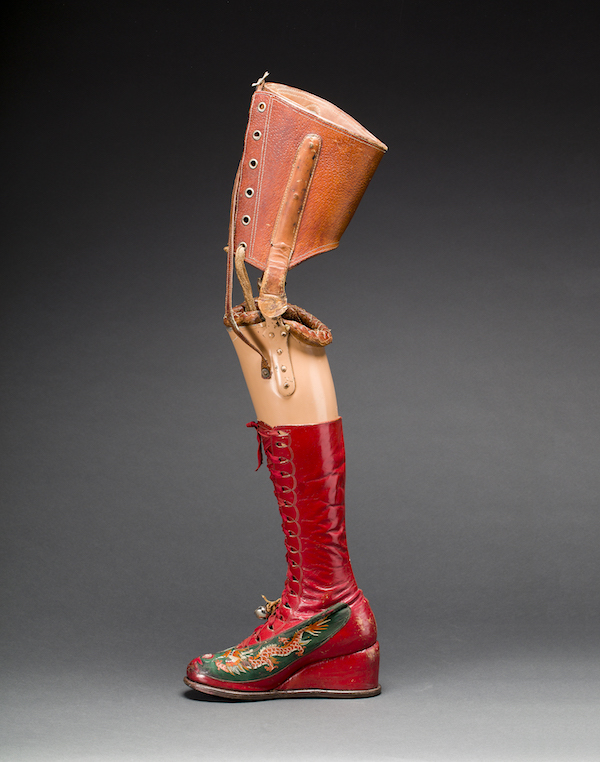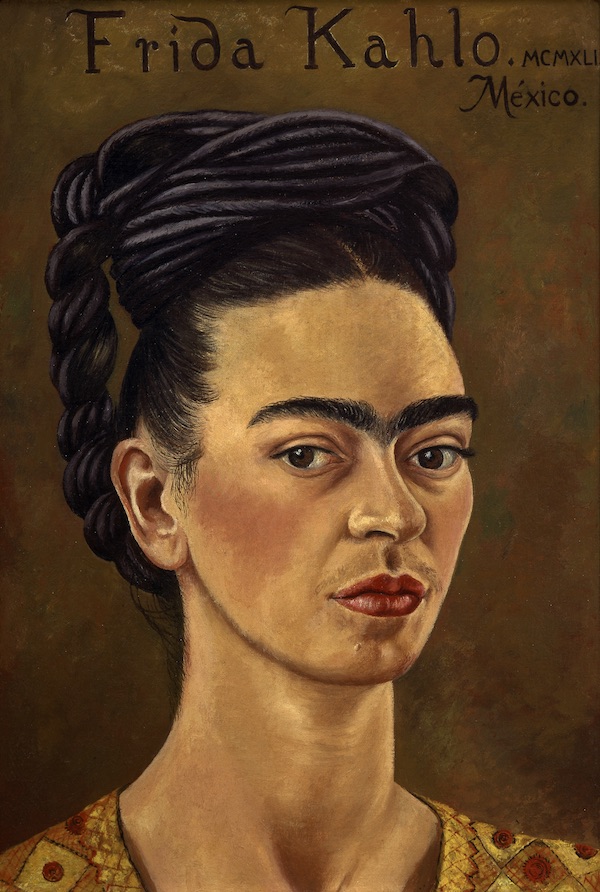Frida Kahlo: Making Her Self Up, V&A review - appearances aren't everything | reviews, news & interviews
Frida Kahlo: Making Her Self Up, V&A review - appearances aren't everything
Frida Kahlo: Making Her Self Up, V&A review - appearances aren't everything
Sumptuous exhibition prioritises image over artist
When in 2004 Frida Kahlo’s bedroom – sealed on the command of her husband Diego Rivera for 50 years from her death – was opened, a trove of clothes and personal items was discovered.
As in her self-portraits which symbolically unpack states of being or dilemmas around her own likeness, Kahlo fashioned a highly personal world within the realms of the Blue House in Mexico City where she was born, lived and died and which is now a museum dedicated to her life and work. At the V&A coloured lighting, surreal cornices and a room-by-room soundtrack create an immersive experience which, if spatially inadequate for the number of visitors, is nevertheless highly effective at conveying the sense of slipping between highly subjective worlds that is so present in her paintings.
 What’s also made apparent is how close to the skin of things significance lay for Kahlo, how meaning resided in each action, each choice, each item. Early on there is a series of strikingly annotated family photographs (her father was a photographer), one with arrows and names directly scrawled on the print identifying family members; another of her christening with ¡idiota! added later on the back as an outraged annotation (as an adult she renounced Catholicism, evincing instead a syncretic interest in Taoism, Hinduism and indigenous beliefs). Later, a hand-drawn birds-eye map annotates the view of her beloved garden (towards her death she asked for her bed to be moved so she could view it better) and late in life her fingers dripped with rings she’d give away to friends as tokens of her affection – her hands literally symbolising friendship.
What’s also made apparent is how close to the skin of things significance lay for Kahlo, how meaning resided in each action, each choice, each item. Early on there is a series of strikingly annotated family photographs (her father was a photographer), one with arrows and names directly scrawled on the print identifying family members; another of her christening with ¡idiota! added later on the back as an outraged annotation (as an adult she renounced Catholicism, evincing instead a syncretic interest in Taoism, Hinduism and indigenous beliefs). Later, a hand-drawn birds-eye map annotates the view of her beloved garden (towards her death she asked for her bed to be moved so she could view it better) and late in life her fingers dripped with rings she’d give away to friends as tokens of her affection – her hands literally symbolising friendship.
But moving a house exhibition to another context will always be difficult, and there’s something about these personal effects being out of their original context which doesn’t quite translate. A further difficulty is that they are clearly used as a run-up to the climax of the exhibition – a room magnificently full of her skirts, shawls and clothes – and the same might be said for the paintings on display, her work uncomfortably servicing her image rather than the other way round.
Moreover, the exhibition suffers somewhat for being overly schematic. Separate sections are dedicated to her clothes, to medicines, to orthopaedic corsets, to the retablos – vernacular paintings offered in churches as thanks – that she and Rivera collected. So each part is immensely clear but also somewhat dense, and connections between the way Kahlo lived, loved, dressed and worked are not so much fluidly drawn as starkly stated. The loose huipil blouses she favoured that were the beautiful corollary of the unbeautiful orthopaedic corsets which supported her spine and alleviated her pain are displayed separately; the flowing skirts that disguised her uneven walk and hid her leg (amputated the year before she died) are in a separate section to the part dedicated to the matriarchal Tehuana culture which she referenced in wearing them. Fashion and medicine in their own ways both alleviated her suffering while somewhat disguising her condition – palliatively from herself, sartorially from others – but in the exhibition they are considered quite separately.
 Sometimes though, her art, her physical frailty and her aesthetic choices come together in striking ways. This is clear in a photograph of her painting Self-Portrait with the Portrait of Doctor Farill, 1951, in front of which Kahlo and Farill replicate their depicted stances. The self-portrait was painted in gratitude for the multiple surgeries he conducted on her spine which alleviated her pain to the extent she was again able to work. Yet in the photograph there is a striking contrast between the fidelity with which Farill has been depicted and the stark distinctions between the painted and the living Frida: in paint, despite the dark print under her eyes suggesting fatigue, she is serene and poised; in the photograph she looks tense with pain, her brow concerned and visibly runched. The illusion is exploded, the layers of artifice temporarily peeled off.
Sometimes though, her art, her physical frailty and her aesthetic choices come together in striking ways. This is clear in a photograph of her painting Self-Portrait with the Portrait of Doctor Farill, 1951, in front of which Kahlo and Farill replicate their depicted stances. The self-portrait was painted in gratitude for the multiple surgeries he conducted on her spine which alleviated her pain to the extent she was again able to work. Yet in the photograph there is a striking contrast between the fidelity with which Farill has been depicted and the stark distinctions between the painted and the living Frida: in paint, despite the dark print under her eyes suggesting fatigue, she is serene and poised; in the photograph she looks tense with pain, her brow concerned and visibly runched. The illusion is exploded, the layers of artifice temporarily peeled off.
There’s a wealth of extraordinary personal artefacts on display, and reams of fascinating information. Highlights include a sumptuous Chinese skirt bought in amazement in San Francisco’s Chinatown; photographs by Kahlo’s then lover Julien Levy as she braided her hair; her prosthetic leg with a cheeky bell attached to the arch (pictured above), and animal doodles she and Rivera sent each other. Her only lithograph, Frida and the Miscarriage, 1932, is on display,as is the richly detailed Self-Portrait on the Borderline Between Mexico and the United States, 1932, (main picture) and the striking Self-Portrait with Braid, 1941. But her actual work seems somewhat crushed beneath a kind of hagiographic celebrity. It’s not that it’s not a compact, sumptuous exhibition but rather that – ironically – it gives more space to who she was and who she seemed to be than what she actually did.
rating
Explore topics
Share this article
The future of Arts Journalism
You can stop theartsdesk.com closing!
We urgently need financing to survive. Our fundraising drive has thus far raised £49,000 but we need to reach £100,000 or we will be forced to close. Please contribute here: https://gofund.me/c3f6033d
And if you can forward this information to anyone who might assist, we’d be grateful.

Subscribe to theartsdesk.com
Thank you for continuing to read our work on theartsdesk.com. For unlimited access to every article in its entirety, including our archive of more than 15,000 pieces, we're asking for £5 per month or £40 per year. We feel it's a very good deal, and hope you do too.
To take a subscription now simply click here.
And if you're looking for that extra gift for a friend or family member, why not treat them to a theartsdesk.com gift subscription?
more Visual arts
 'We are bowled over!' Thank you for your messages of love and support
Much-appreciated words of commendation from readers and the cultural community
'We are bowled over!' Thank you for your messages of love and support
Much-appreciated words of commendation from readers and the cultural community
 Lee Miller, Tate Britain review - an extraordinary career that remains an enigma
Fashion photographer, artist or war reporter; will the real Lee Miller please step forward?
Lee Miller, Tate Britain review - an extraordinary career that remains an enigma
Fashion photographer, artist or war reporter; will the real Lee Miller please step forward?
 Kerry James Marshall: The Histories, Royal Academy review - a triumphant celebration of blackness
Room after room of glorious paintings
Kerry James Marshall: The Histories, Royal Academy review - a triumphant celebration of blackness
Room after room of glorious paintings
 Folkestone Triennial 2025 - landscape, seascape, art lovers' escape
Locally rooted festival brings home many but not all global concerns
Folkestone Triennial 2025 - landscape, seascape, art lovers' escape
Locally rooted festival brings home many but not all global concerns
 Sir Brian Clarke (1953-2025) - a personal tribute
Remembering an artist with a gift for the transcendent
Sir Brian Clarke (1953-2025) - a personal tribute
Remembering an artist with a gift for the transcendent
 Emily Kam Kngwarray, Tate Modern review - glimpses of another world
Pictures that are an affirmation of belonging
Emily Kam Kngwarray, Tate Modern review - glimpses of another world
Pictures that are an affirmation of belonging
 Kiefer / Van Gogh, Royal Academy review - a pairing of opposites
Small scale intensity meets large scale melodrama
Kiefer / Van Gogh, Royal Academy review - a pairing of opposites
Small scale intensity meets large scale melodrama
 Jenny Saville: The Anatomy of Painting, National Portrait Gallery review - a protégé losing her way
A brilliant painter in search of a worthwhile subject
Jenny Saville: The Anatomy of Painting, National Portrait Gallery review - a protégé losing her way
A brilliant painter in search of a worthwhile subject
 Abstract Erotic, Courtauld Gallery review - sculpture that is sensuous, funny and subversive
Testing the boundaries of good taste, and winning
Abstract Erotic, Courtauld Gallery review - sculpture that is sensuous, funny and subversive
Testing the boundaries of good taste, and winning
 Edward Burra, Tate Britain review - watercolour made mainstream
Social satire with a nasty bite
Edward Burra, Tate Britain review - watercolour made mainstream
Social satire with a nasty bite
 Ithell Colquhoun, Tate Britain review - revelations of a weird and wonderful world
Emanations from the unconscious
Ithell Colquhoun, Tate Britain review - revelations of a weird and wonderful world
Emanations from the unconscious
 Rachel Jones: Gated Canyons, Dulwich Picture Gallery review - teeth with a real bite
Mouths have never looked so good
Rachel Jones: Gated Canyons, Dulwich Picture Gallery review - teeth with a real bite
Mouths have never looked so good

Add comment